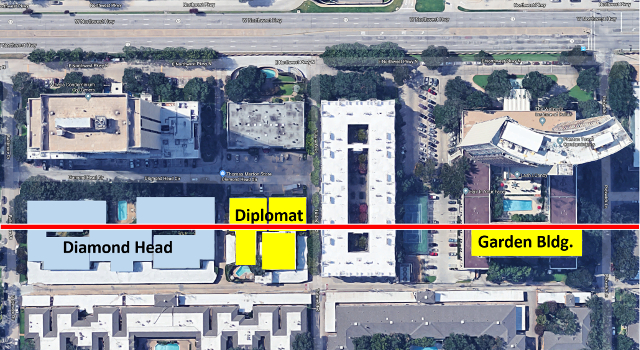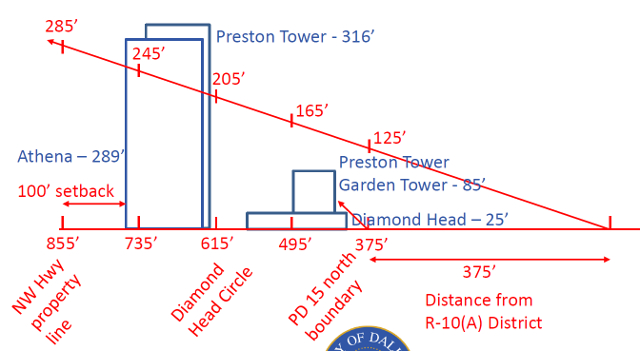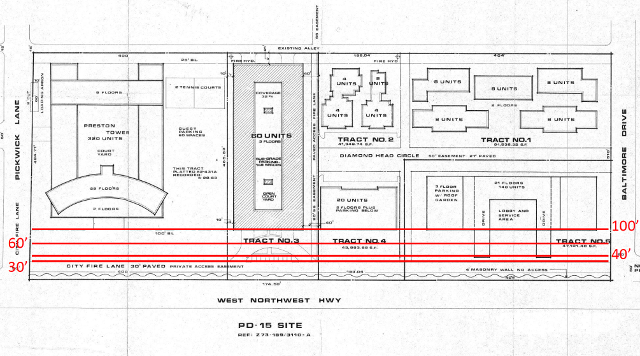by Jon Anderson
Candy's Dirt

Tower Spacing: Through Thick and Thin, Thick Matters
There’s a bit of a special language being formulated between the Authorized Hearing committee members. For example, when the city facilitator recaps a prior discussion by saying, “We agreed on X,” a committee member or two will pipe up “We didn’t agree on that.” What they really mean is they didn’t. And since they didn’t agree, there could be no agreement. Everyone believing they’re getting 100 percent out of this is a recipe for nothing ever being decided. Ancient children not wanting to share their toys.
Parking
The session revolved around a review of responses to last meeting’s homework on a variety of topics, and trying to get some consensus. The first of those topics was a discussion of parking requirements. In many regards it was a pointless discussion. The committee members are not parking experts so to ask their opinion on whether it should be one space per bedroom, 1.5 spaces per unit or two spaces is all so much guesswork. Woven into this was the fear that developers would build too much parking and be left with a surplus once Uber took over the world.
Here’s the thing, there’s never unused parking in multifamily developments. If there was a global automobile rapture tomorrow, parking spaces would be repurposed for storage (much to the chagrin of the storage industry), or amenity space, or even built out for additional living space (above-ground, flat garages). It’s not like it would go to waste. So don’t worry about too much, only too little.
There was light discussion on street parking with a few wanting to eliminate it. But you can’t really. Each building will likely maintain a handful of outside spaces for drop-offs, quick visits and the like, where going into a garage is a little silly.
Beyond numbers, most seemed OK with at least some above-ground parking so long as it was camouflaged in some way (wrapped in apartments or attractively screened). I did smile at one response that thought underground parking should be required for Athena and Preston Tower as though they should dig a hole 50 years post-construction.

Height Limits Using RPS. (Boo-boo: Preston Tower is 8-stories taller than Athena but only 17′ taller?)
Residential Proximity Slope (RPS)
You recall, RPS is not required for PD-15 but many want to see how using RPS would play out. RPS is a slope that runs from single-family neighborhoods towards areas with higher allowable buildings. It’s designed to curtail tall buildings from looming over homes by pulling them back and away. Think about the stair-step buildings you see at Preston Center along the tollway that pull away from Devonshire.
RPS caused a lot of heebie-jeebies. Diamond Head Condos’ representative was particularly vocal about not wanting to be subjected to the measure because it would limit their redevelopment from infinite height.
But the funniest head-snapping happened when someone said RPS should be used, and that the Athena and Preston Tower should be subjected to it should they ever redevelop voluntarily or as a result of an act of nature (shrinking their allowed heights). You never saw two grandmothers stammer “grandfather” so fast. You see, they’re OK dictating to everyone else and giving no purchase, but limiting their properties sent a few volts through.
And you know what? As negative and stingy as the towers have been, were I a low-rise representative, I’d make it my life’s work to tie the Athena and Preston Tower to the RPS.
Sorta in the same ballpark as RPS is Tower Spacing – step-backs when two tall buildings are too close. Athena said “yes” and Diamond Head said “no.” I say “yes” and here’s why:
Everyone points to Preston Tower’s garden building, saying it’s not on top of Preston Tower, but here’s the thing: The garden building is two units deep. Diplomat and Diamond Head are two buildings deep with a slight separation. This makes their buildings twice as thick as the garden building and therefore twice as close to their neighbors. As it stands, there is a wider separation between Diplomat and Royal Orleans already, but Athena and Diamond Head get REALLY cramped at height. If Diamond Head Condos is going to extend into the residential floor plane of Athena there needs to be a step back. I would daresay that the complexes on Diamond Head’s northern boundary would want a step back, too.
Oh, and by the way, it doesn’t matter what I, Athena, or Diamond Head think. PD-15 states that if some parameter is silent in the PD-15 documents, it defaults to MF-(3) within Chapter 51. Tower Spacing is denoted in Chapter 51. While the committee may be empowered to waive it, unlike RPS, they’re already governed by it. City staff seemed to position it as an option. Not really. It’s there.
One protectionist thing the towers representative said I did agree with: Diamond Head lamented having to look out her window at the tall face of Athena. The response to Diamond Head was, “you knew what you were buying” – and they’re right. It’s a corollary to moving next to an airport and complaining about the noise. I have no sympathy for that argument.
Diamond Head Condos
This is as good a place as any to say that Diamond Head annoyed me last night. I’m not telling tales out of class here as I spoke to their representative after the meeting. Their goal last night for any dimension was the tallest, widest, densest structure possible – more than a little greed. She said later that she figured the city would probably not approve such a building, but they wanted an enormous envelope so a developer could then fight it out at City Hall.
The first thing I said was that her unrealistic excessiveness was scaring people and causing some to dig their heels in (counterproductive in a negotiation). The second thing is that a huge envelope that you then leave the city to decipher misses a trick. The wonderful thing about this often-confusing and frustrating process is that it places a level of control in the neighborhood BEFORE projects go to Plan Commission and City Council. Why would you want two sets of eyes on something instead of three? Especially when one of the sets is the very local neighborhood that can add some specific tweaking that might not matter to the city, but would matter a great deal to the neighborhood?
What I didn’t say, only because it occurred to me later, was that even if a virtually unlimited buildable envelope was given, the city would knock it down to something realistic when a developer tried to fill it. Developers don’t pay on “maybe,” they pay on “permits.” So whatever a developer agreed to pay (on contingent) for a seemingly unlimited envelope would be discounted right back to what they got permitted. So there is no point in getting a bazillion dollar buildable envelope when the city will only ultimately approve a quarter of a bazillion dollar project. The ultimate money paid to the landowner is the same. But the process is stretched out unnecessarily due to the battles that would be fought and it needlessly scares the behoozis out if the neighborhood. Ultimately it serves everyone if you work towards an 80-90 percent nailed down envelope so a developer only needs minor tweaks.

Setback relief could eat into the frontage road??
Setbacks
More comedy ensued on setbacks. I’m going out on a limb and say this homework question wasn’t explained very well. There is an existing 100-foot setback from Northwest Highway north to Preston Tower, Preston Place, Royal Orleans, and Athena. As far as I’ve determined, it’s in each of the building’s deeds. But the question asked what an appropriate setback should be.
Before getting to the responses, it’s important to know that the actual Pink Wall from Northwest Highway to the first curb is about five feet. Then there’s a parallel parking lane across most of the stretch (call it 10 feet). Then there’s a generous two lane road. After that there’s differing land uses before hitting a building. All totaled, 100 feet.
Three committee members were OK with a 30-foot setback from the “property line” which is Northwest Highway. That would result in a building almost in the middle of the frontage road. At 40 feet, it would only be a handful of feet north of the roadway before a sheer face of building would be possible.
Maybe you want to rethink that. Not only would it pull the buildings out of alignment, but it would be fairly ugly (you don’t see single-family homes next to the sidewalk either).
There is really only one reason to even consider this – Royal Orleans. While Preston Place has all the land it needs at about two acres, Royal Orleans sits on a lot made tiny by required setbacks on all four sides. If they could build significantly into the 100 foot Northwest Highway setback, it would make their property more valuable. But at what cost to the neighborhood aesthetic? The building already encroaches onto the 100-foot setback with a yard and pool that pinches the frontage road.
Their representative seemed to be advocating for zero setback outside the frontage road. This would add about 65 feet to their buildable lot and pull one building significantly out of alignment. Coupled with their desire for the “front” of their building to face Diamond Head Circle leaving the frontage road framed by a tall, sheer block jutting out of alignment and into the view plane.
No. I’m sorry, that’s too much ugly to swallow. I didn’t design PD-15 and the current owners of Royal Orleans likely didn’t purchase with the hope of cashing out to a developer (and if they did, they shouldn’t have bought the smallest plot in the area). Sure, it’s frustrating and feels unfair when neighboring buildings are able to redevelop into more salable projects, but life ain’t fair. While some accommodations may be made, Royal Orleans’ dirt simply isn’t worth as much because there isn’t enough of it.
Also, Royal Orleans has been in talks with Preston Place’s buyer, Provident. If Provident connects the two parcels, no setback relief is needed, period. And the neighborhood certainly doesn’t need both buildings to be pulled forward.
Side And Alley Setbacks
Who’d a thunk there could be so much hoo-ha about alley setbacks. They’re currently 20 feet which essentially equates to the carports lining the alley. For some reason city staff kept harping on wanting sidewalks in the alley. Why? Leisurely strolls by mechanicals, HVAC chillers, and whiffy dumpsters all while gazing poetically up at power lines?
Side lot setbacks range from 10-to-40 feet with a patchwork of sidewalks. I urge ALL committee members to carpool around Uptown, Oak Lawn, and Knox and look at new apartment buildings and their setbacks. Most are 10-ish feet plus a sidewalk – pretty dang close to the street. Put in perspective, my sofa is 10 feet long, and as a setback not too impressive. As for sidewalk width, let’s call it a two-scooter passing width.
Height And Density
The question of height returned silly answers. Responses were cast for all the low-rises between 25 and 330 feet tall. Density-wise, responses ranged from existing units per acre to 160 per acre (35 units per acre MORE than A.G. Spanos is asking for seems excessive). Helpful, no?
The Athena and Preston Tower were pegged at their existing heights with other replies including RPS (205′-285′ – or 125′ for garden building), 250′, and 330 feet tall. Ditto on density here too – existing to 160 per acre. Again, not too helpful.
One committee member’s math skills proved shy of the mark. It was posited that $700,000 townhouses would be just as profitable for everyone. Nope. Here’s the deal: assuming the average footprint of a townhouse and cramming 15 on an acre (pretty crammed), that’s a project value of $10.5 million. I believe A.G Spanos proposed Diplomat project (about an acre) will have a done-done value of $50 million give or take. If we believe the rumor of an $18.5 million price on Preston Place’s two acres, Provident would only have $2.5 million left for a full build out. Certainly to err is human.
Leading The Kitties To Water
This meeting city staff were more noticeable in their opinion on the path forward. Some found this off-putting, but I was thrilled. Without someone to help guide this process and capture decisions when made, this process would stumble on longer than a Law & Order franchise. As long as staff isn’t putting words in the committee’s mouths, I’m good with a little cat herding.
Remember: High-rises, HOAs and renovation are my beat. But I also appreciate modern and historical architecture balanced against the YIMBY movement. In 2016, 2017 and 2018, the National Association of Real Estate Editors recognized my writing with three Bronze (2016, 2017, 2018) and two Silver (2016, 2017) awards. Have a story to tell or a marriage proposal to make? Shoot me an email sharewithjon@candysdirt.com. Be sure to look for me on Facebook and Twitter. You won’t find me, but you’re welcome to look.